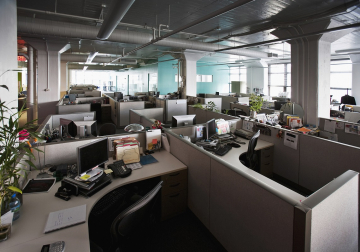Lighting. Climate. Smell. Sound. It’s time to embrace a more holistic definition and approach to ergonomics: environmental ergonomics.
Fit the job to the person. This classic ergonomics principle has been a guiding light for forward-thinking environment, health, and safety (EHS) leaders for decades. The comfort of employees is a component to their success and the success of the business.
Often, the focus and emphasis of ergonomics is concentrated on workstation equipment and design—with other environmental factors such as climate or noise living on the periphery.
Today, ergonomics in the workplace must extend beyond layout and design if EHS leaders want to make a more positive impact on worker health and safety and the business. It’s time to embrace a more holistic definition and approach to ergonomics.
Here are four key environmental factors that impact worker health and safety in the workplace and why they need to be on your ergonomics radar.
The Lighting Factor
The effects of poor lighting in the workplace are wide-ranging. From combating glare and fatigue to obscuring slip, trip, or fall hazards, poor lighting isn’t just a health and safety risk, but it’s also a productivity and comfort killer.
For example, we’ve all spent time in a workplace with less-than-desirable lighting. An impeding glare from a bright overhead light lives on your computer screen, and you’re minutes away from installing a patio umbrella as a permanent fixture. You resolve to make the best of it, squinting your eyes or adjusting your body position. But ultimately, without good lighting ergonomics, you’re losing momentum and focus as your eyes and body work harder. Conversely, light levels that are too low can also cause discomfort, and in some cases, affect overall vision.
Simply put, lighting matters. That means ensuring that adequate lighting is installed (and maintained) throughout your facility and that employees are placed correctly in relation to the overheads. And don’t forget to install appropriate window treatments to ensure computer screens or other necessary equipment aren’t obstructed by sunlight. Additionally, consider task lighting to allow employees additional adjustability.
The Climate Factor
People simply work better in a comfortable climate. And there are three main components of perceived climate comfort: air quality, air temperature, and air movement.
Air Quality
According to the EPA, the average American spends up to 90% of their time indoors—and most of their working hours in an office environment. While most buildings are well run and able to manage air quality, occasionally issues can occur such as extreme weather, fires, and equipment failure.
The bottom line? Improved indoor air quality within the workplace keeps workers comfortable, making it a sound people and business investment.
Air Temperature
Over the years, several studies have shown that office temperature and productivity are linked; as temperature increases, productivity decreases. Your employees need that “just right” temperature—which also factors in humidity—around the office to keep them comfortable and focused.
Generally speaking, that sweet spot is somewhere around 70 degrees Fahrenheit, or 21.5 degrees Celsius, and low humidity. But it’s also important to note that this recommended temperature is subject to employee gender, age, weight, and other human factors. It may be impossible to account for each individual, however, depending on your workplace makeup this can be a helpful consideration.
To help maintain a comfortable temperature, work with your building manager or engage a partner to assess your HVAC system’s capabilities and perhaps install temperature and humidity controls.
Air Movement
Stale, stagnant air is never a good thing. Moving air throughout your office space requires proper ventilation, which helps control temperatures, reduce pollutants, and keep clean air flowing freely throughout the office. Fans also prove useful for ventilation and circulation in, particularly hot workplaces.
But there’s an important caveat to consider: while ventilators, fans, and HVAC systems can all work together to improve airflow and air quality, they can be noisy—which can also impact employee comfort and productivity. (More on that in the next section.)
The Noise Factor
Depending on the industry you work in and the size of your company, the noise level in your office can vary from peaceful to pandemonium, and everything in between. Maintaining the right levels of office background noise is critical to minimizing distractions and enhancing productivity.
To reduce office background noise coming from office equipment like computers, fans, foot traffic, and workplace conversations, we recommend moving louder equipment to separate rooms, away from offices and cubicles, as well as having multiple offices/touch down areas where employees can have conversations without disturbing their coworkers. Another tactic is adding sound-absorbing dividers and carpeting to further reduce noise levels around the workplace.
When it comes to other facilities such as warehouses or distribution centers, ensure that employees have the proper protective equipment such as earplugs or noise-canceling headphones, to meet the requirements of your Hearing Protection Program.
The Smell Factor
Strange or unpleasing odors can be a major distraction and productivity inhibitor (and are probably caused by a coworker who regularly brings in broccoli to heat up for lunch.) So, how can you reduce common workplace odors to increase the comfort and happiness of your employees?
In addition to proper ventilation, set and communicate some simple rules and expectations for employees to follow. For example, create a schedule for cleaning out the community fridge, microwave, sink, or breakroom every Friday. Empower employees to take the trash out when it’s full and at the end of each day.
If body odor is the issue, or someone in the office is wearing a little too much perfume or cologne, the best approach is to pull the individual aside and address the issue one-on-one in conjunction with Human Resources.
Rethink Traditional Ergonomics to Drive Holistic Environmental Improvements
Having the right equipment and workplace design are critical ergonomic drivers. But it’s time to think beyond layout and bring environmental ergonomic factors such as lighting, climate, noise, and sound into the fold.
When you do this, the positive impact will be felt at the individual and business levels. In fact, studies show that comfortable, well-lit, well-ventilated, and safe workplaces increase worker productivity by as much as 16% and job satisfaction by 24%. And happier, more productive workers can lead to better retention, better work, and reduced costs.
Ready to improve the ergonomics in your workplace? An ergonomic assessment should be your starting point.
Learn more about our ergonomics assessment services.
Want more news and insights like this?
Sign up for our monthly e-newsletter, The New Leaf. Our goal is to keep you updated, educated and even a bit entertained as it relates to all things EHS and sustainability.
Get e-NewsletterHave any questions?
Contact us to discuss your environment, health, safety and sustainability needs today.





